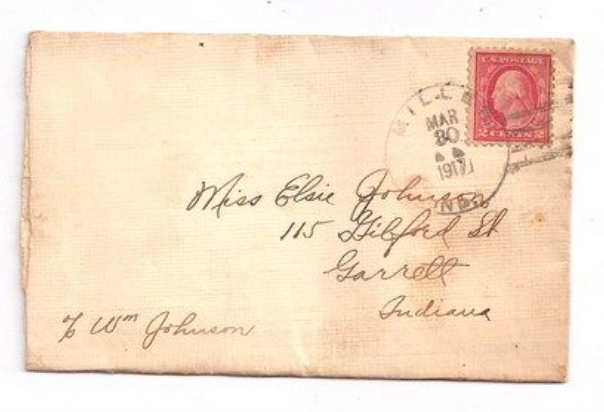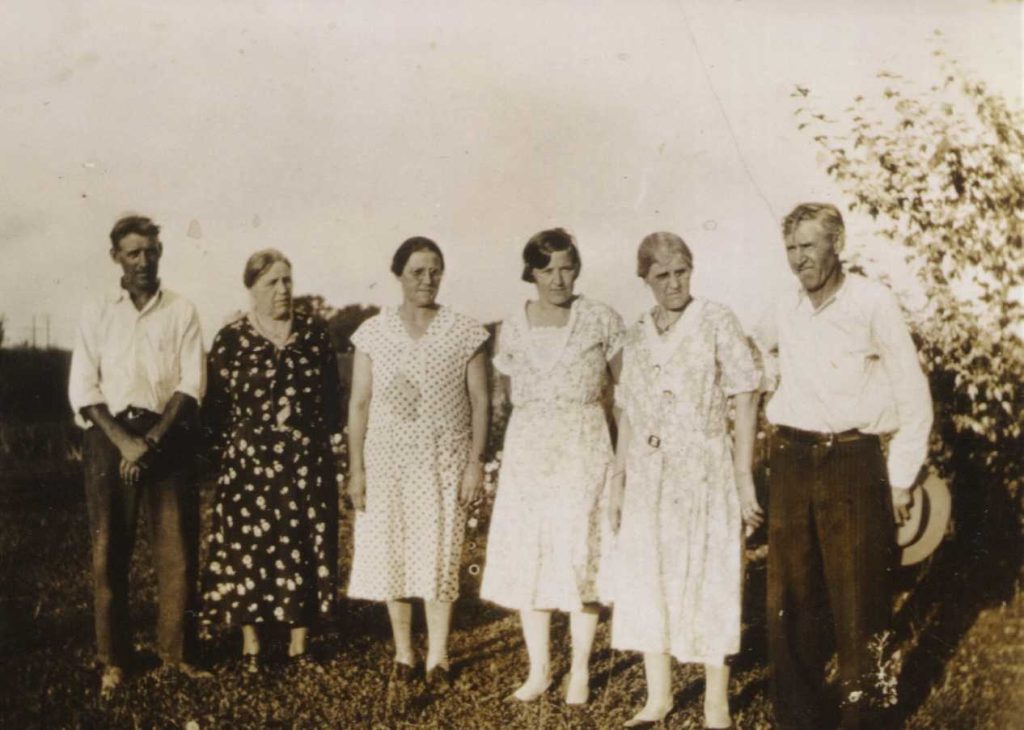
Last week I began the saga of how I finally broke through two brick walls; I had two baptismal certificates but could find no information on what had become of the individuals. My goal has always been to find closer family and return the certificates. You can catch up on the story by reading Part 1 here.
TALK IT OUT
I shared what I had found with my family and my concern I didn’t have the right man. My husband said, to his knowledge, none of his family had ever lived in northwestern Indiana. This conversation led to a list of places he knew his family had lived – Fayette County in the 1820s, the Elkhart/South Bend area since the 1830s, Porter and Lake counties since the 1850s. I clearly remembered he had some relatives in the late 1800s in the Muncie and Bloomington areas but Garrett, nope, never heard of that. Only, I had, but didn’t remember!
In the conversation we had about people moving about I recalled a letter his grandmother had received from someone about a motorcycle trip that they had taken to North Dakota. I decided to go back through the old letters to find out who that person was. While doing that, I solved my brick wall. . .
TRANSCRIBE
The envelope I found (shown above) shocked me as it was written to his grandmother who was living in Garrett in c/o Wm. Johnson. I immediately showed my husband and he said, “No way.” I then discovered I had a letter written from Garrett to a “Dear Sister” in 1911.
After transcribing the letter, I analyzed it for further clues. The problem with the letter, however, was that there was no envelope, it was signed by “Anna and Dickie” and written to “Dear Sister.” Most of the letters in the collection were written to Elsie Johnson Harbaugh, Oskar’s half-sister, so that was likely who the sister was. The marriage license for Oskar was to a woman named Anna Blair, so the writer may have been Anna but who was Dickie? No Oskar, Willie, or William is ever mentioned in the letter.
RESEARCH OTHERS LISTED
Clearly, the letter was not written by Oskar as the letter writer stated:
1. “I have six brothers, all married.” Anders and Thilda’s sons were Johan, Carl, Oscar, Charlie, Willie, and Andrew. Those are 6 boys, however, the letter writer would not have included himself in the count of people he had to write to and why would he inform his half-sister of his siblings as she would have already known that information?
2.“I have one brother in Chicago, has lived there, for more than six years, ever since he was married, he is an electrician.” I had no idea where most of the children from the first marriage lived. Their sister, Ida, lived in Chicago with her husband, Charles Johnberg, in 1920. The couple married in Porter County, Indiana in 1917. They would not have been in Chicago together in 1912 when the letter was written.
3. “also one sister and two other brothers that are single.” The sons from the first marriage had four full sisters–Anna, Ida, Selma, and Nellie, who had probably died by the time the letter was written, and three half-sisters–Helen, Elsie, and Ruth, so this did not fit with Oskar or one of his siblings being the letter writer.
4.“I live right across the street from my Mother, or I don’t know what I would do.” The mother of the sons died in 1891.
It was time to research Anna Blair who married William Johnson in Garrett, DeKalb, Indiana in June 1911. From the 1920 US federal census, William was shown working in Garrett as a brakeman on the railroad. The letter mentions that Dickie worked on the railroad. William was living with his wife, Anna, son Eugene, and brother Andrew, who likely was the Anders Teodor I had a baptism certificate for. Next door to the couple is Fred and Josephine Blair, likely the parents of Anna Blair. Researching Anna further showed that indeed, her parents were Fred and Josephine Blair. Anna did have six married brothers with one who lived in Chicago and was an electrician. In 1911, she also had a sister and two brothers who were single. Her siblings were William, Franklin, Fredrick, John, Andrew, Leo, Oscar, Claude, and Hattie. She also noted that she lived right across the street from her mother which the census supports. So, Anna Blair, wife of William Johnson, was writing the letter probably to Elsie, William’s half-sister.
GET CREATIVE WITH NAMES
But I still didn’t know who Dickie was! Anna and William’s son was named Eugene in the 1920 census. Was Oskar-Willie-William-also being called Dickie?! I decided to further research Eugene.
An Indiana birth certificate shows that the son was named Eugene Richard Johnson. Dickie was probably the child’s nickname based on his middle name. Perhaps Oskar liked the name and Anna was using it for him, too. I’m beginning to think it was a family tradition to just pull a name out of nowhere and begin using it.
As I continued to research the family to discover what became of them, as I was hoping I could find a living relative to return the baptism certificate to, I discovered that Anna was listed as a widow in the 1930 US Federal census. I have been unable to find a death certificate for Oskar, though, through newspaper research, found that he died in 1929 in South Bend, Indiana. He had left railroad work after representing his fellow employees and was unsuccessful in negotiating with management to remove armed guards from the trains in Garrett. At the time of his death, he was working as a welder in an automobile plant. At age 41, he died of a heart attack. Anna returned with Dickie to live in Garrett. It was there she had Oskar entombed in a mausoleum in a Roman Catholic Cemetery. Oskar’s baptism certificate was for the Lutheran faith. The cemetery was established for Roman Catholics in the late 1800s, however, it did accept other Christian denominations for separate burials. Don’t discount a burial in a cemetery of another faith! Remember, if there was no pre-planning the dead don’t get any say in where they are laid to rest. Interestingly, Oskar lies in the mausoleum which I’ve been told by the present owners, is not their responsibility and they don’t know who actually owns it. It is also a mixed burial site, meaning anyone of any faith is buried there. The records for the mausoleum are also missing so I can’t find who paid for the burial. I also can’t enter it as when we tried to visit it was locked. The present owners of the cemetery, the Roman Catholic Church, do not have a key and didn’t know that the door locked. Sigh!
The tombstone and findagrave.com memorial for Oskar is listed as Wm. O. Johnson. So, the records were now showing that Oskar Wilhelm Johannesson in 1886 became Willie Jonshon in 1900 and by 1911 William Johnson. In 1917, his wife was referring to him as Dickie in family correspondence but the 1920 census shows him as William Johnson. When he was buried, his wife had his tombstone engraved as Wm. O. Johnson. I’m guessing the O was for Oskar.
I have located and reached out to Oskar Wilhelm – Willie – William – Dickie – Wm. O.’s sole living grandchild as I would like to finally, after 44 years, return the baptismal certificate to a closer relative. So far, the grandchild hasn’t responded.
Research shows that I’ll be keeping Anders Teodor – Andrew’s baptismal certificate as, after Oskar left Garrett, Anders returned to live in Porter County, Indiana. He never married and was killed by an automobile as he walked along the side of a road in 1933, shortly after the only known picture of him was taken with his siblings. This also explains why Oskar wasn’t pictured; he was likely dead. The photo was probably not from circa the late 1920s but circa the early 1930s.
My distant cousin William Shakespeare wrote that “a rose by any other name would smell as sweet;” I believe that applies to solving a brick wall with whatever name the individual wanted to be called by. Anders Ludvig Johannesson became Gust Johnson; Oskar Wilhem Johanson becomes William “Dickie” O. Johnson. For all these years I had the clues to solve the puzzle but it took experience, FAN research, a 111-year-old letter, a 105-year-old envelope, and online databases to crack the mystery.
I will be taking the next two weeks off for the holidays. Hope whatever you celebrate is merry and bright – see you in January 2023!



